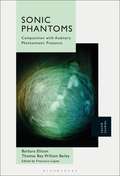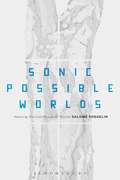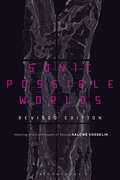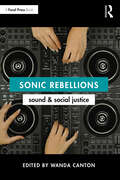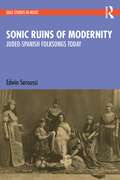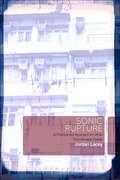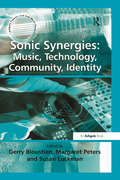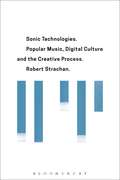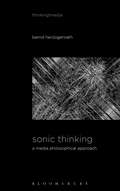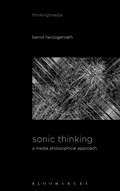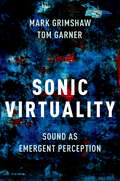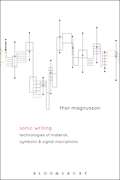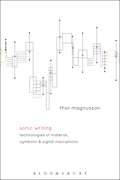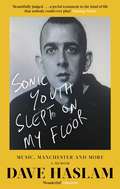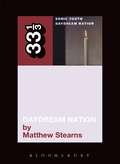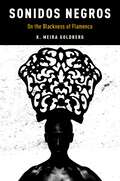- Table View
- List View
Sonic Phantoms: Composition with Auditory Phantasmatic Presence
by Barbara Ellison Thomas Bey BaileyIn this book, Barbara Ellison and Thomas B. W. Bailey lay out and explore the mystifying and evanescent musical territory of 'sonic phantoms': auditory illusions within the musical material that convey a 'phantasmatic' presence. Structured around a large body of compositional work developed by Ellison over the past decade, sonic phantoms are revealed and illustrated as they arise through a diverse array of musical sources, materials, techniques, and compositional tools: voices (real and synthetic), field recordings, instrument manipulation, object amplification, improvisation, and recording studio techniques. Somehow inherent in all music--and perhaps in all sound--sonic phantoms lurk and stalk with the promise of mystery and elevation. We just need to conjure them.
Sonic Possible Worlds: Hearing the Continuum of Sound
by Salomé VoegelinInspired by its use in literary theory, film criticism and the discourse of game design, Salomé Voegelin adapts and develops “possible world theory” in relation to sound. David K Lewis' Possible World is juxtaposed with Maurice Merleau-Ponty's life-world, to produce a meeting of the semantic and the phenomenological at the place of listening. The central tenet of Sonic Possible Worlds is that at present traditional musical compositions and contemporary sonic outputs are approached and investigated through separate and distinct critical languages and histories. As a consequence, no continuous and comparative study of the field is possible. In Sonic Possible Worlds, Voegelin proposes a new analytical framework that can access and investigate works across genres and times, enabling a comparative engagement where composers such as Henry Purcell and Nadia Boulanger encounter sound art works by Shilpa Gupta and Christina Kubisch and where the soundscape compositions of Chris Watson and Francisco López resound in the visual worlds of Louise Bourgeois.
Sonic Possible Worlds: Hearing the Continuum of Sound
by Salomé VoegelinInspired by its use in literary theory, film criticism and the discourse of game design, Salomé Voegelin adapts and develops “possible world theory” in relation to sound. David K Lewis' Possible World is juxtaposed with Maurice Merleau-Ponty's life-world, to produce a meeting of the semantic and the phenomenological at the place of listening. The central tenet of Sonic Possible Worlds is that at present traditional musical compositions and contemporary sonic outputs are approached and investigated through separate and distinct critical languages and histories. As a consequence, no continuous and comparative study of the field is possible. In Sonic Possible Worlds, Voegelin proposes a new analytical framework that can access and investigate works across genres and times, enabling a comparative engagement where composers such as Henry Purcell and Nadia Boulanger encounter sound art works by Shilpa Gupta and Christina Kubisch and where the soundscape compositions of Chris Watson and Francisco López resound in the visual worlds of Louise Bourgeois.
Sonic Possible Worlds, Revised Edition: Hearing the Continuum of Sound
by Salomé VoegelinFrom its use in literary theory, film criticism and the discourse of games design, Salomé Voegelin expands 'possible world theory' to think the worlding of sound in music, in art and in the everyday. The modal logic of possible worlds, articulated principally via David K. Lewis and developed through Maurice Merleau-Ponty's phenomenological life-worlds, creates a view on the invisible slices of the world and reflects on how to make them count, politically and aesthetically. How to make them thinkable and accessible as the possibility of the everyday and of art: to reach a new materialist understanding from the invisible and to develop an ear for the as yet inaudible.Creating Sonic Possible Worlds, such a phenomenological modality offers a new analytical framework that listens across genres and times to hear the continuum between sound art and music and to grasp the plurality of the world. This revised edition continues Voegelin's exploration of the sonic possibility of the world into the sonic possibility and impossibility of the body. Listening to works by Áine O'Dwyer, Hannah Silva and Jocy de Oliveira, it considers sonic possible worlds' radical power to rethink normative constructions and to fabulate a different body from its sound. Thus, the word continuum in the subtitle of this book, Hearing the Continuum of Sound, which in the first edition stood principally for the continuum between music and sound art, is opened up to denote also another continuum that stands as principle for the body, while including that of sound: Hearing the Continuum Between Plural Bodies Breathing, between humans-humanoid aliens-monsters-vampires-animals-plants-things-and anything we have no name for yet but which a sonic philosophy might start to hear and call.
Sonic Possible Worlds, Revised Edition: Hearing the Continuum of Sound
by Salomé VoegelinFrom its use in literary theory, film criticism and the discourse of games design, Salomé Voegelin expands 'possible world theory' to think the worlding of sound in music, in art and in the everyday. The modal logic of possible worlds, articulated principally via David K. Lewis and developed through Maurice Merleau-Ponty's phenomenological life-worlds, creates a view on the invisible slices of the world and reflects on how to make them count, politically and aesthetically. How to make them thinkable and accessible as the possibility of the everyday and of art: to reach a new materialist understanding from the invisible and to develop an ear for the as yet inaudible.Creating Sonic Possible Worlds, such a phenomenological modality offers a new analytical framework that listens across genres and times to hear the continuum between sound art and music and to grasp the plurality of the world. This revised edition continues Voegelin's exploration of the sonic possibility of the world into the sonic possibility and impossibility of the body. Listening to works by Áine O'Dwyer, Hannah Silva and Jocy de Oliveira, it considers sonic possible worlds' radical power to rethink normative constructions and to fabulate a different body from its sound. Thus, the word continuum in the subtitle of this book, Hearing the Continuum of Sound, which in the first edition stood principally for the continuum between music and sound art, is opened up to denote also another continuum that stands as principle for the body, while including that of sound: Hearing the Continuum Between Plural Bodies Breathing, between humans-humanoid aliens-monsters-vampires-animals-plants-things-and anything we have no name for yet but which a sonic philosophy might start to hear and call.
Sonic Rebellions: Sound and Social Justice
by Wanda CantonSonic Rebellions combines theory and practice to consider contemporary uses of sound in the context of politics, philosophy, and protest, by exploring the relationship between sound and social justice, with particular attention to sonic methodologies not necessarily conceptualised or practiced in traditional understandings of activism.An edited collection written by artists, academics, and activists, many of the authors have multidimensional experiences as practitioners themselves, and readers will benefit from never-before published doctoral and community projects, and innovative, audio-based interpretations of social issues today. Chapters cover the use of soundscapes, rap, theatre, social media, protest, and song, in application to contemporary socio-political issues, such as gentrification, neoliberalism, criminalisation, democracy, and migrant rights. Sonic Rebellions looks to encourage readers to become, or consider how they are, Sonic Rebels themselves, by developing their own practices and reflections in tandem to continue the conversation as to how sound permeates our sociopolitical lives.This is an essential resource for those interested in how sound can change the world, including undergraduates and postgraduates from across the social sciences and humanities, scholars and instructors of sound studies and sound production, as well as activists, artists, and community organisers.
Sonic Rebellions: Sound and Social Justice
Sonic Rebellions combines theory and practice to consider contemporary uses of sound in the context of politics, philosophy, and protest, by exploring the relationship between sound and social justice, with particular attention to sonic methodologies not necessarily conceptualised or practiced in traditional understandings of activism.An edited collection written by artists, academics, and activists, many of the authors have multidimensional experiences as practitioners themselves, and readers will benefit from never-before published doctoral and community projects, and innovative, audio-based interpretations of social issues today. Chapters cover the use of soundscapes, rap, theatre, social media, protest, and song, in application to contemporary socio-political issues, such as gentrification, neoliberalism, criminalisation, democracy, and migrant rights. Sonic Rebellions looks to encourage readers to become, or consider how they are, Sonic Rebels themselves, by developing their own practices and reflections in tandem to continue the conversation as to how sound permeates our sociopolitical lives.This is an essential resource for those interested in how sound can change the world, including undergraduates and postgraduates from across the social sciences and humanities, scholars and instructors of sound studies and sound production, as well as activists, artists, and community organisers.
Sonic Ruins of Modernity: Judeo-Spanish Folksongs Today (SOAS Studies in Music)
by Edwin SeroussiSonic Ruins of Modernity shows how social, cultural and cognitive phenomena interact in the making and distribution of folksongs beyond their time. Through Judeo-Spanish (or Ladino) folksongs, the author illustrates a methodology for the interplay of individual memories, artistic initiatives, political and media policies, which ultimately shape “tradition” for the past century. He fleshes out in a series of case studies how folksongs can be conceived, performed and circulated in the post-tradition era – constituting each song as a “sonic ruin,” as an imagined place. At the same time, the book overall provides a unique perspective on the history of the Judeo-Spanish folksong.
Sonic Ruins of Modernity: Judeo-Spanish Folksongs Today (SOAS Studies in Music)
by Edwin SeroussiSonic Ruins of Modernity shows how social, cultural and cognitive phenomena interact in the making and distribution of folksongs beyond their time. Through Judeo-Spanish (or Ladino) folksongs, the author illustrates a methodology for the interplay of individual memories, artistic initiatives, political and media policies, which ultimately shape “tradition” for the past century. He fleshes out in a series of case studies how folksongs can be conceived, performed and circulated in the post-tradition era – constituting each song as a “sonic ruin,” as an imagined place. At the same time, the book overall provides a unique perspective on the history of the Judeo-Spanish folksong.
Sonic Rupture: A Practice-led Approach to Urban Soundscape Design
by Jordan LaceySonic Rupture applies a practitioner-led approach to urban soundscape design, which foregrounds the importance of creative encounters in global cities. This presents an alternative to those urban soundscape design approaches concerned with managing the negative health impacts of noise. Instead, urban noise is considered to be a creative material and cultural expression that can be reshaped with citywide networks of sonic installations. By applying affect theory the urban is imagined as an unfolding of the Affective Earth, and noise as its homogenous (and homogenizing) voice. It is argued that noise is an expressive material with which sonic practitioners can interface, to increase the creative possibilities of urban life. At the heart of this argument is the question of relationships: how do we augment and diversify those interconnections that weave together the imaginative life and the expressions of the land? The book details seven sound installations completed by the author as part of a creative practice research process, in which the sonic rupture model was discovered. The sonic rupture model, which aims to diversify human experiences and urban environments, encapsulates five soundscape design approaches and ten practitioner intentions. Multiple works of international practitioners are explored in relation to the discussed approaches. Sonic Rupture provides the domains of sound art, music, creative practice, urban design, architecture and environmental philosophy with a unique perspective for understanding those affective forces, which shape urban life. The book also provides a range of practical and conceptual tools for urban soundscape design that can be applied by the sonic practitioner.
Sonic Rupture: A Practice-led Approach to Urban Soundscape Design
by Jordan LaceySonic Rupture applies a practitioner-led approach to urban soundscape design, which foregrounds the importance of creative encounters in global cities. This presents an alternative to those urban soundscape design approaches concerned with managing the negative health impacts of noise. Instead, urban noise is considered to be a creative material and cultural expression that can be reshaped with citywide networks of sonic installations. By applying affect theory the urban is imagined as an unfolding of the Affective Earth, and noise as its homogenous (and homogenizing) voice. It is argued that noise is an expressive material with which sonic practitioners can interface, to increase the creative possibilities of urban life. At the heart of this argument is the question of relationships: how do we augment and diversify those interconnections that weave together the imaginative life and the expressions of the land? The book details seven sound installations completed by the author as part of a creative practice research process, in which the sonic rupture model was discovered. The sonic rupture model, which aims to diversify human experiences and urban environments, encapsulates five soundscape design approaches and ten practitioner intentions. Multiple works of international practitioners are explored in relation to the discussed approaches. Sonic Rupture provides the domains of sound art, music, creative practice, urban design, architecture and environmental philosophy with a unique perspective for understanding those affective forces, which shape urban life. The book also provides a range of practical and conceptual tools for urban soundscape design that can be applied by the sonic practitioner.
Sonic Synergies: Music, Technology, Community, Identity
by Gerry BloustienSonic Synergies: Music, Technology, Community, Identity focuses on the new and emerging synergies of music and digital technology within the new knowledge economies. Eighteen scholars representing six international perspectives explore the global and local ramifications of rapidly changing new technologies on creative industries, local communities, music practitioners and consumers. Diverse areas are considered, such as production, consumption, historical and cultural context, legislation, globalization and the impact upon the individual. Drawing on a range of musical genres from jazz, heavy metal, hip-hop and trance, and through several detailed case studies reflecting on the work of professional and local amateur artists, this book offers an important discussion of the ways in which the face of music is changing. Approaching these areas from a cultural studies perspective, this text will be a valuable tool for anyone engaged in the study of popular culture, music or digital technologies.
Sonic Synergies: Music, Technology, Community, Identity
by Gerry BloustienSonic Synergies: Music, Technology, Community, Identity focuses on the new and emerging synergies of music and digital technology within the new knowledge economies. Eighteen scholars representing six international perspectives explore the global and local ramifications of rapidly changing new technologies on creative industries, local communities, music practitioners and consumers. Diverse areas are considered, such as production, consumption, historical and cultural context, legislation, globalization and the impact upon the individual. Drawing on a range of musical genres from jazz, heavy metal, hip-hop and trance, and through several detailed case studies reflecting on the work of professional and local amateur artists, this book offers an important discussion of the ways in which the face of music is changing. Approaching these areas from a cultural studies perspective, this text will be a valuable tool for anyone engaged in the study of popular culture, music or digital technologies.
Sonic Technologies: Popular Music, Digital Culture and the Creative Process
by Robert StrachanIn the past two decades digital technologies have fundamentally changed the way we think about, make and use popular music. From the production of multimillion selling pop records to the ubiquitous remix that has become a marker of Web 2.0, the emergence of new music production technologies have had a transformative effect upon 21st Century digital culture. Sonic Technologies examines these issues with a specific focus upon the impact of digitization upon creativity; that is, what musicians, cultural producers and prosumers do. For many, music production has moved out of the professional recording studio and into the home. Using a broad range of examples ranging from experimental electronic music to more mainstream genres, the book examines how contemporary creative practice is shaped by the visual and sonic look and feel of recording technologies such as Digital Audio Workstations.
Sonic Technologies: Popular Music, Digital Culture and the Creative Process
by Robert StrachanAwarded a Certificate of Merit at the ARSC Awards for Excellence 2018In the past two decades digital technologies have fundamentally changed the way we think about, make and use popular music. From the production of multimillion selling pop records to the ubiquitous remix that has become a marker of Web 2.0, the emergence of new music production technologies have had a transformative effect upon 21st Century digital culture. Sonic Technologies examines these issues with a specific focus upon the impact of digitization upon creativity; that is, what musicians, cultural producers and prosumers do. For many, music production has moved out of the professional recording studio and into the home. Using a broad range of examples ranging from experimental electronic music to more mainstream genres, the book examines how contemporary creative practice is shaped by the visual and sonic look and feel of recording technologies such as Digital Audio Workstations.
Sonic Thinking: A Media Philosophical Approach (Thinking Media)
by Bernd HerzogenrathSonic Thinking attempts to extend the burgeoning field of media philosophy, which so far is defined by a strong focus on cinema, to the field of sound. The contributors urge readers to re-adjust their ideas of Sound Studies by attempting to think not only about sound [by external criteria, such as (cultural) meaning], but to think with and through sound. Series editor Bernd Herzogenrath's collection serves two interconnected purposes: in developing an alternative philosophy of music that takes music serious as a 'form of thinking'; and in bringing this approach into a fertile symbiosis with the concepts and practices of 'artistic research': art, philosophy, and science as heterogeneous, yet coequal forms of thinking and researching. Including contributions by both established figures and younger scholars working on cutting edge material, and weaving artistic responses and interventions in between the more theoretical texts, Herzogenrath's collection provides a lively introduction to a fresh debate.
Sonic Thinking: A Media Philosophical Approach (Thinking Media)
by Bernd HerzogenrathSonic Thinking attempts to extend the burgeoning field of media philosophy, which so far is defined by a strong focus on cinema, to the field of sound. The contributors urge readers to re-adjust their ideas of Sound Studies by attempting to think not only about sound [by external criteria, such as (cultural) meaning], but to think with and through sound. Series editor Bernd Herzogenrath's collection serves two interconnected purposes: in developing an alternative philosophy of music that takes music serious as a 'form of thinking'; and in bringing this approach into a fertile symbiosis with the concepts and practices of 'artistic research': art, philosophy, and science as heterogeneous, yet coequal forms of thinking and researching. Including contributions by both established figures and younger scholars working on cutting edge material, and weaving artistic responses and interventions in between the more theoretical texts, Herzogenrath's collection provides a lively introduction to a fresh debate.
Sonic Virtuality: Sound as Emergent Perception
by Mark Grimshaw Tom GarnerIn Sonic Virtuality: Sound as Emergent Perception, authors Mark Grimshaw and Tom Garner introduce a novel theory that positions sound within a framework of virtuality. Arguing against the acoustic or standard definition of sound as a sound wave, the book builds a case for a sonic aggregate as the virtual cloud of potentials created by perceived sound. The authors build on their recent work investigating the nature and perception of sound as used in computer games and virtual environments, and put forward a unique argument that sound is a fundamentally virtual phenomenon. Grimshaw and Garner propose a new, fuller and more complete, definition of sound based on a perceptual view of sound that accounts more fully for cognition, emotion, and the wider environment. The missing facet is the virtuality: the idea that all sound arises from a sonic aggregate made up of actual and virtual sonic phenomena. The latter is a potential that depends upon human cognition and emotion for its realization as sound. This thesis is explored through a number of philosophical, cognitive, and psychological concepts including: issues of space, self, sonosemantics, the uncanny, hyper-realism, affect, Gettier problems, belief, alief, imagination, and sound perception in the absence of sound sensation. Provocative and original, Grimshaw and Garner's ideas have broader implications for our relationship to technology, our increasingly digital lives, and the nature of our being within our supposed realities. Students and academics from philosophy to acoustics and across the broad spectrum of digital humanities will find this accessible book full of challenging concepts and provocative ideas.
Sonic Writing: Technologies of Material, Symbolic, and Signal Inscriptions
by Thor MagnussonSonic Writing explores how contemporary music technologies trace their ancestry to previous forms of instruments and media. Studying the domains of instrument design, musical notation, and sound recording under the rubrics of material, symbolic, and signal inscriptions of sound, the book describes how these historical techniques of sonic writing are implemented in new digital music technologies. With a scope ranging from ancient Greek music theory, medieval notation, early modern scientific instrumentation to contemporary multimedia and artificial intelligence, it provides a theoretical grounding for further study and development of technologies of musical expression. The book draws a bespoke affinity and similarity between current musical practices and those from before the advent of notation and recording, stressing the importance of instrument design in the study of new music and projecting how new computational technologies, including machine learning, will transform our musical practices.Sonic Writing offers a richly illustrated study of contemporary musical media, where interactivity, artificial intelligence, and networked devices disclose new possibilities for musical expression. Thor Magnusson provides a conceptual framework for the creation and analysis of this new musical work, arguing that contemporary sonic writing becomes a new form of material and symbolic design--one that is bound to be ephemeral, a system of fluid objects where technologies are continually redesigned in a fast cycle of innovation.
Sonic Writing: Technologies of Material, Symbolic, and Signal Inscriptions
by Thor MagnussonSonic Writing explores how contemporary music technologies trace their ancestry to previous forms of instruments and media. Studying the domains of instrument design, musical notation, and sound recording under the rubrics of material, symbolic, and signal inscriptions of sound, the book describes how these historical techniques of sonic writing are implemented in new digital music technologies. With a scope ranging from ancient Greek music theory, medieval notation, early modern scientific instrumentation to contemporary multimedia and artificial intelligence, it provides a theoretical grounding for further study and development of technologies of musical expression. The book draws a bespoke affinity and similarity between current musical practices and those from before the advent of notation and recording, stressing the importance of instrument design in the study of new music and projecting how new computational technologies, including machine learning, will transform our musical practices.Sonic Writing offers a richly illustrated study of contemporary musical media, where interactivity, artificial intelligence, and networked devices disclose new possibilities for musical expression. Thor Magnusson provides a conceptual framework for the creation and analysis of this new musical work, arguing that contemporary sonic writing becomes a new form of material and symbolic design--one that is bound to be ephemeral, a system of fluid objects where technologies are continually redesigned in a fast cycle of innovation.
Sonic Youth Slept On My Floor: Music, Manchester, and More: A Memoir
by Dave Haslam'Beautifully judged account of the Manchester scene . . . There is something of the fairy tale about Dave Haslam's sage joyful testament to the kind of life that nobody could ever plan, a happy aligning of a cultural moment and a young man who instinctively knew that it was his once upon a time' Victoria Segal, Sunday Times'Witty, sometimes dark, revealing, insightful, everything one could hope for from one of those folk without whom independent music simply wouldn't exist' Classic RockSonic Youth Slept on My Floor is writer and DJ Dave Haslam's wonderfully evocative memoir. It is a masterful insider account of the Hacienda, the rise of Madchester and birth of the rave era, and how music has sound-tracked a life and a generation.In the late 1970s Dave Haslam was a teenage John Peel listener and Joy Division fan, his face pressed against a 'window', looking in at a world of music, books and ideas. Four decades later, he finds himself in the middle of that world, collaborating with New Order on a series of five shows in Manchester. Into the story of those intervening decades, Haslam weaves a definitive portrait of Manchester as a music city and the impact of a number of life-changing events, such as the nightmare of the Yorkshire Ripper to the shock of the Manchester Arena terror attack.The cast of Haslam's life reads like a who's who of '70s, '80s and '90s popular culture: Tony Wilson, Nile Rodgers, Terry Hall, Neneh Cherry, Tracey Thorn, John Lydon, Johnny Marr, Ian Brown, Laurent Garnier and David Byrne. From having Morrissey to tea and meeting writers such as Raymond Carver and Jonathan Franzen to discussing masturbation with Viv Albertine and ecstasy with Roisin Murphy, via having a gun pulled on him at the Hacienda and a drug dealer threatening to slit his throat, this is not your usual memoir.
Sonic Youth's Daydream Nation (33 1/3)
by Matthew StearnsDaydream Nation is the kind of gorgeous monstrosity (born of extremes, rife with difficulties, and mythic in proportion) that can crush the will of the most resilient, well-intentioned listener if the necessary preparations haven't been made. Matthew Stearns explores the album from a range of angles, including a track-by-track analysis and a look at the historical and cultural context within which the album was made. Featuring a foreword by Lee Ranaldo and exclusive interviews with the band, this truly is the definitive guide to Daydream Nation.
Sonic Youth's Daydream Nation (33 1/3)
by Matthew StearnsDaydream Nation is the kind of gorgeous monstrosity (born of extremes, rife with difficulties, and mythic in proportion) that can crush the will of the most resilient, well-intentioned listener if the necessary preparations haven't been made. Matthew Stearns explores the album from a range of angles, including a track-by-track analysis and a look at the historical and cultural context within which the album was made. Featuring a foreword by Lee Ranaldo and exclusive interviews with the band, this truly is the definitive guide to Daydream Nation.
Sonidos Negros: On the Blackness of Flamenco (Currents in Latin American and Iberian Music)
by K. Meira GoldbergHow is the politics of Blackness figured in the flamenco dancing body? What does flamenco dance tell us about the construction of race in the Atlantic world? Sonidos Negros traces how, in the span between 1492 and 1933, the vanquished Moor became Black, and how this figure, enacted in terms of a minstrelized Gitano, paradoxically came to represent Spain itself. The imagined Gypsy about which flamenco imagery turns dances on a knife's edge delineating Christian and non-Christian, White and Black worlds. This figure's subversive teetering undermines Spain's symbolic linkage of religion with race, a prime weapon of conquest. Flamenco's Sonidos Negros live in this precarious balance, amid the purposeful confusion and ruckus cloaking embodied resistance, the lament for what has been lost, and the values and aspirations of those rendered imperceptible by enslavement and colonization.
SONIDOS NEGROS ON BLACKN OF FLAM CILAM C: On the Blackness of Flamenco (Currents in Latin American and Iberian Music)
by K. Meira GoldbergHow is the politics of Blackness figured in the flamenco dancing body? What does flamenco dance tell us about the construction of race in the Atlantic world? Sonidos Negros traces how, in the span between 1492 and 1933, the vanquished Moor became Black, and how this figure, enacted in terms of a minstrelized Gitano, paradoxically came to represent Spain itself. The imagined Gypsy about which flamenco imagery turns dances on a knife's edge delineating Christian and non-Christian, White and Black worlds. This figure's subversive teetering undermines Spain's symbolic linkage of religion with race, a prime weapon of conquest. Flamenco's Sonidos Negros live in this precarious balance, amid the purposeful confusion and ruckus cloaking embodied resistance, the lament for what has been lost, and the values and aspirations of those rendered imperceptible by enslavement and colonization.
